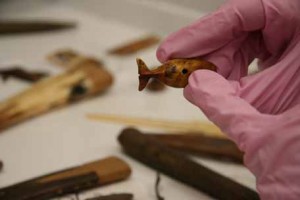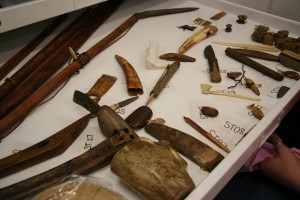Former PBS host shares grandfather’s Point Hope legacy
March 4, 2011

Theresa Bakker
907-474-6941
3/4/11
A recent donation to the University of Alaska Museum of the North’s ethnology collection chronicles a family’s connection to the village of Point Hope back to the early part of last century.
Collection manager Angela Linn can offer bits of information about each of them. The sewing kit has a sealskin leather needle case that threads through an ivory tube; the scrapers dangling from the end were made with jade or chert, a flint-like rock. The sealskin boots with bearded seal bottoms and sheepskin liners are probably from the 1980s. The sealskin scabbard possibly served as a quiver, but more likely sheathed a rifle.
The items come from the personal collection of Steve Thomas, the former host of PBS' “This Old House.” His grandfather, the Rev. William Thomas, served as a missionary in Point Hope from 1914 until 1926, where he purchased the pieces or received them as gifts. Steve Thomas recently donated the items to the museum.
“This is our first donation from a high profile person from outside the world of anthropology who just happened to have a historic collection important to Alaska,” Linn said.
The Rev. William Thomas was a protégé of Hudson Stuck, the Episcopalian archdeacon who defended the rights of Alaska Natives and helped organize the first successful ascent of Mount McKinley in 1913. Thomas forged a lasting connection with the community, something his grandson discovered when he visited himself.
“I showed up in Point Hope unannounced in the early 1980s to see if someone would take me whaling,” Steve Thomas said. “There I was, walking to town after everybody else had been picked up by friends and relatives when the guy who handled the baggage gave me a ride.”
Their conversation quickly turned to the reason Thomas had decided to visit Point Hope. Thomas mentioned his grandfather’s service as a missionary and his friendship with one family in particular, so he was taken to their home.
“As soon as I pulled out the pictures, they said, ‘You have to stay with us! We’re brothers,’” he said.
Photographs make up the bulk of the Thomas collection, so the donation started with Peggy Asbury, the acting archivist at the Alaska and Polar Regions Collection at the Elmer E. Rasmuson Library at UAF.
“What we have are journals and correspondence, along with lots and lots of photographs,” Asbury said. “That’s three cubic feet of material to be processed.”

Asbury recommended that the remaining items be given to the museum. Linn knew the collection was something special after her analysis led to a connection with Knud Rasmussen’s fifth Thule Expedition.
"Rasmussen was a Greenlandic Inuit speaker who launched a major expedition and was the first to make a cultural connection among the peoples of the Arctic,” she said. “He noted in his writings that William Thomas welcomed the group to Point Hope in 1925. I love finding nuggets of information like that.”
Asbury agreed that the collection is an important one.
“Not only does it document life from 1914 to 1926, it documents life at Point Hope, Alaska and the different churches that had an impact on that region, missionaries in general and Hudson Stuck,” she said. “For any archivist, the goal is to have research materials in a place that makes sense for people to look.”
Linn will continue to work with the collection, identifying and labeling each item. Eventually people from all over the world will be able to learn something from Steve's grandfather, the way he already has.
"He died when I was about six, but I have strong memories of him," said Thomas. "I've been able to uncover layer after layer of this rich history and connection that my family had with Point Hope, represented by these photographs and artifacts."
ADDITIONAL CONTACTS: Angela Linn, museum ethnology collection manager, 907-474-1828, ajlinn@alaska.edu.
ON THE WEB: museum.uaf.edu
TB/3-4-11/166-11


